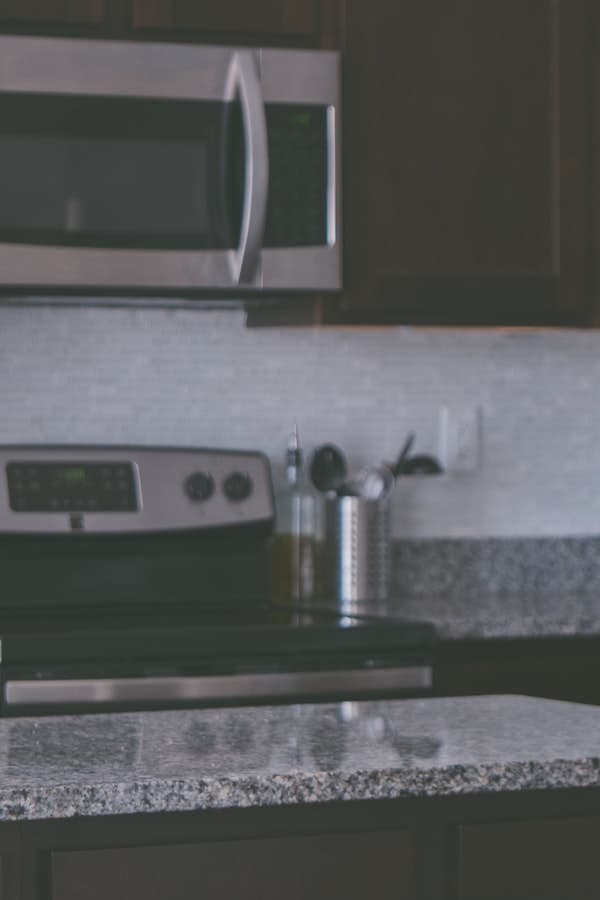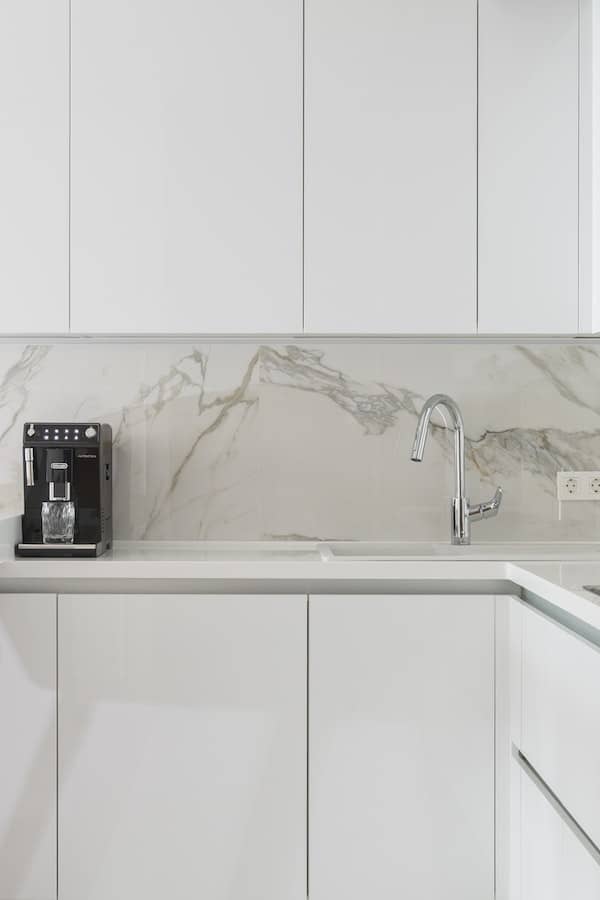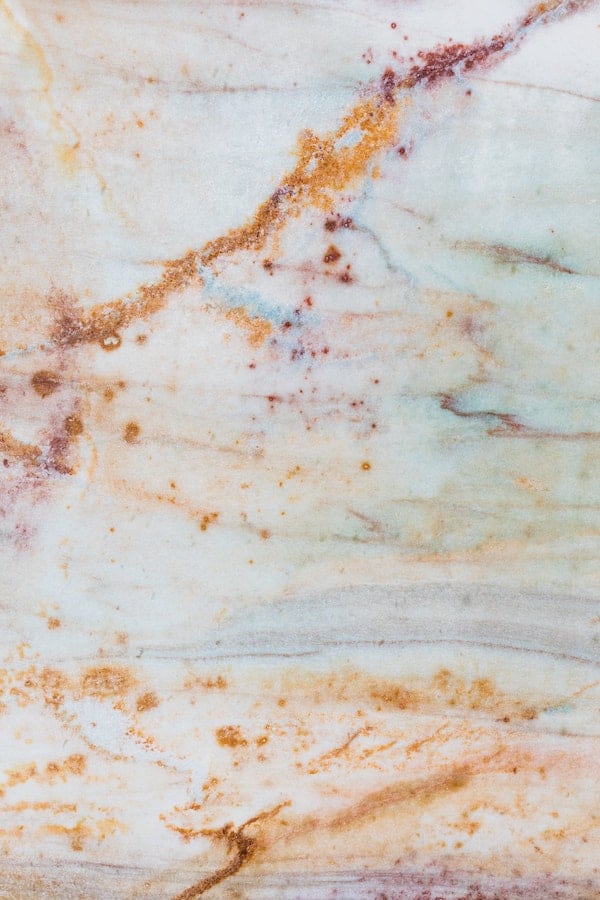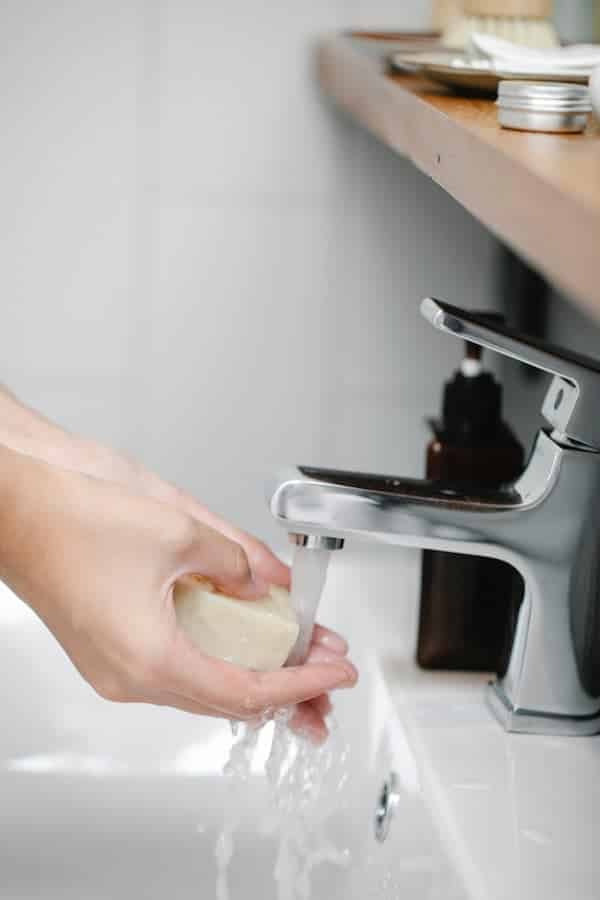Marble is an abundant natural stone often used as countertops in kitchens and the wall coverings of bathrooms. However, it is at risk of being stained by water over time, which causes ugly, stubborn stains.
This article will describe three methods for removal; soap, baking soda, and hydrogen peroxide.
Marble is a popular choice in people’s homes, particularly in kitchens and for fireplaces. But, more significantly, it is also a substantial investment.
This beautiful natural stone is often regarded as extremely tough wearing. However, it is incredibly susceptible to water stains.
This article will first explain why water is so adequate at staining this robust stone before describing three effective methods which can be utilized at home to clear them for good.
There may be affiliate links in this article. You can read more about this in my disclosure.
Why Does Water Stain Marble?

Marble is considered a beautiful and luxurious material. Beyond that, it is regarded as a dense and immensely strong material, often requiring industrial diamond blades to cut them.
So how can it be possible that water can penetrate and stain it?
Firstly, marble is a surprisingly porous material. It contains tiny, microscopic holes on the material’s surface, allowing substances to penetrate it.
Staining is often the result of water sitting on the surface for an extended period, allowing the water to be absorbed by the marble slowly.
Marble is a popular choice in people’s homes, particularly in kitchens and for fireplaces. These areas of a house are notably susceptible to foreign materials landing on them for long periods.
Often it is recommended that the marble is sealed with an epoxy or varnish to form an impenetrable layer. Sealing is not a foolproof solution, but it can certainly help minimize staining for shorter periods and from other damaging substances.
Although marble is a robust material, it is still susceptible to chips, scratches, and scuffs over time. Once these occur, they provide additional entry points for water to penetrate the surface of the marble and leave an unsightly stain.

Surprisingly, the quality and composition of water can impact the marble stain’s intensity and severity.
For example, suppose the water is hard and specifically rich in salts like calcium and magnesium. In that case, marble can be particularly susceptible to staining as the minerals remain in the marble after the water has later evaporated.
If minerals are allowed to build up over time, and with repeat exposure, they will leave a very tough and noticeable hue on your marble. This is a problem that is often associated with kitchen countertops near a sink.
A less common but a more significant problem can occur if water is contaminated with heavy metals such as iron or magnesium. These heavier metals will not just create a darker hue on the marble but will actually change its color to red or green.
Marble may remain a popular choice, but there are some significant risks involved with owning it.
What Are the Qualities of Marble?

Marble is considered one of the highly robust and beautiful materials which are appreciated the world over. It embodies elegance and sophistication combined with a formidable reputation that will last forever.
Surprisingly, marble is not one of the toughest natural stones. Compared to granite or quartz, it is actually on the lower end of the toughness scale.
This is a common misconception. However, it is often overlooked due to its centuries-old reputation, rumored to have been used as far back as the 3rd century BC.
What makes marble so desirable is its uniquely beautiful composition. Depending on its chemical makeup, it can come in an almost endless variety of beautiful colors and tones, which intertwine to produce a stunning effect.
Both of these elements of marble ownership should be taken into consideration. It may not be as hard-wearing as some other building materials, but the trade-off is that it is a stunning.
How to Remove Marble Water Stains with Soap?

Sometimes most simple options are the right ones. Although there are various options, you can, of course, stick to old-fashioned soap to tackle your marble water stains.
Dish soap is a superb all-around cleaning tool for around your home. From sterilizing your cutlery to mopping your floor, it really does have endless uses.
That includes tackling those stubborn water stains too.
For this method, it is vital that you use a neutral soap that does not have any added fragrances like lemon. This is because the added chemicals can react with the marble and stain it further.
The first steps are simply to get a bucket of water, soap, and a soft sponge. Now it is time to start scrubbing.
Elbow grease is a crucial component of this method because any added chemical power does not back you up.
Make sure you rinse the sponge regularly to ensure any of the mineral buildups are removed quickly. Otherwise, the loose particles can end up scrapping the surface as you are scrubbing.
If the stain is particularly stubborn, you can use very fine steel wool with a 0000 rating. This is an ultra-delicate version of steel wool which is purposely designed to tackle unwanted grim and material without damaging the surface.
You must rinse and check the stain regularly if you use steel wool. Even though it is a soft method, if you overdo it, you will permanently damage the marble turning the ugly stain into ugly scratches.
[amazon box=”B07HKR2QP9,B000T9ODX2,B074MDTWQR” grid=”3″]How to Remove Marble Water Stains with a Baking Soda Poultice?
Sometimes we encounter grime in our homes that require more than elbow grease. In these scenarios, it is often helpful to utilize the natural chemicals we have in our homes to take on these challenging stains and grime.
One of the best go-to natural substances in our homes is baking soda. Baking soda in an alkali is an adequate, safe chemical substitute for scrubbing.
However, its properties are naturally corrosive to grime and stains.
Moreover, baking soda also acts as a delicate abrasive agent too. It typically comes in a powdered form in which the particles gently erode the grime or stains it is being applied to.
Baking soda is also very easy to use. All you will need is a bowl, some water, and, ideally, some plastic wrap or a bag.
Firstly you will mix a cup of soda with just enough water to make the consistency of a paste. Then you generously apply the paste to the stained area, ensuring a thick layer over every affected area.
Now cover the area in plastic. This will retain heat over the surface, allowing the soda to react optimally.
It is essential to wait at least overnight, if not 24 hours. Once the time is up, you can scrape off the dried paste and have a look at your results!
If you can still see some of the stains left, you can try to repeat this process. This is a more delicate approach which means you will not damage the marble, but it may not always be the most potent option.
[amazon box=”B074J7X1DN” template=”vertical”]How to Remove Water Stains from Marble with Hydrogen Peroxide?
For adamant stains, you must find an exceptionally rugged cleaning agent. In this case, hydrogen peroxide can be an excellent tool for natural stone.
Hydrogen peroxide contains a potent corrosive agent which can be highly effective on marble stains, particularly for a mineral buildup from hard water exposure. But, with harsher chemicals, it is crucial to be more meticulous with your timings and quantities.
For this method, you will need hydrogen peroxide, latex gloves, a cloth, and some cream of tartar. Cream of tartar is a powder often used in home baking, but, like baking soda, it is often used as a home cleaning agent.
To begin, put on your latex gloves and start to sprinkle the cream of tartar powder over the stained area. Put on the gloves, then apply enough hydrogen peroxide to mix with the powder to become a paste.
Mix thoroughly over the affected surface and leave it to cure for 30 minutes. Make sure you do not let it sit for much longer, as there longer the chemicals are exposed to the marble, the greater the chance of permanently discoloring the surface.
After 30 minutes, wipe with a damp cloth and inspect the results. The stain has likely been entirely removed.
Once you are sure it is gone, make sure you do not leave any residual paste, as it is both hazardous and has the potential to damage the marble if it is left for a prolonged period.
[amazon box=”B01AW1HYIC,B07VVFZNQL,B07GBDBHJ2″ grid=”3″]Conclusion
In many cases, water stains are an inevitable annoyance. Nothing is worse than your expensive marble countertop becoming discolored and ugly over time.
But the three methods above are practical and simple home remedies, which should be your first port of call when those nasty stains appear. Fortunately, baking soda, soap, and hydrogen peroxide are most likely already in your home.
So if you encounter a stain, simply follow the steps, and you will easily be on your way to reinvigorating your marble.



